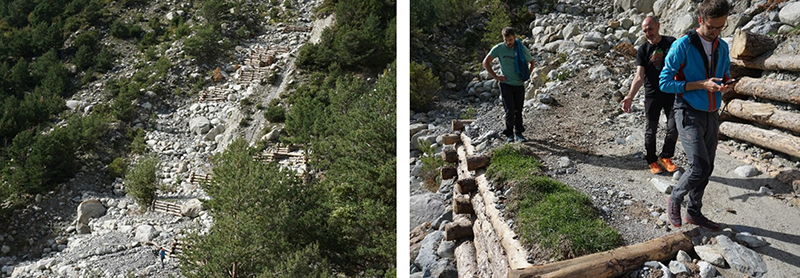Informations
Solution ID
Description of solution
The village of Erill-la-Vall in the Spanish Pyrenees is heavily affected by erosion and debris flow problems, where sediments are fed from tributary creeks and into a main debris flow channel leading to the village. The source area consists of thick (>50 m) deposits of glacial till. The annual precipitation of the area is about 1100 mm/year, mainly in the fall and spring. However, intensive showers in July-August seem to have the worst effect on the debris flow potential.
Through the H2020 project PHUSICOS a combination of revegetation to limit erosion and of terraces constructed by dry stone walls and timber to minimize energy in the creeks and to avoid further lowering of the erosional level, all to reduce the feeding of sediments to the main debris flow channel, and thereby reduce the hazard posed to the village have been implemented.
The NBS measures consist of terraces constructed by dry stone walls and timber. These are constructed in the lower parts of the steepest part of the two main gullies. The terraces are to be covered with organic soil and planted with local vegetation; grass, bushes, and trees. Soil and turf from the area is used, and natural fertilizers from local grazing animals are used on the terraces. About 2500 plants will be used, all local species (Betula pendula, Salix purpurea, Salix caprea, Rhamnus alpina, Viburnum opulus, Corylus avellana, Prunus spinosa, Fraxinus excelsior and Salix sp.). The terraces are constructed starting from below and as high up as possible with an excavator.
The NBS measures will work in combination with rigid and flexible (grey) barriers downslope of the terraces.
The job was done by a small, local company and an enthusiastic excavator driver, who got interest for the project and saw this as a challenge. This is mentioned because most larger construction companies probably would not have taken on this job due to high economic (as well as physical) risk.
Co-benefits:
- improved sense of safety among the population
- less need for costly maintenance
- positive effect on the terrestrial plant ecology of the area
- positive effect on tourism in the area, i.e., an economic co-benefit
Challenges for the implementations encountered in the Pyrenees are mainly bureaucratic and related to the procurement process as well as to obtain necessary permissions to do the work. For the e Erill-la-Vall sites, local interest and enthusiasm were important enablers and ensured fast initiation of the work.
Keywords
Exposition
Actors
- The revegetation and terraces construction have been implemented through the H2020 project PHUSICOS.
- The activities are coordinated by CTP (e Consorcio de la Comunidad de Trabajo de los Pirineos), but the proponents and 'owners' of the implemented measures are the Municipality of Vall de Boi
- The job was done by a small, local company
Temporal aspects
Others


The given position is not exactly where the measure is implemented